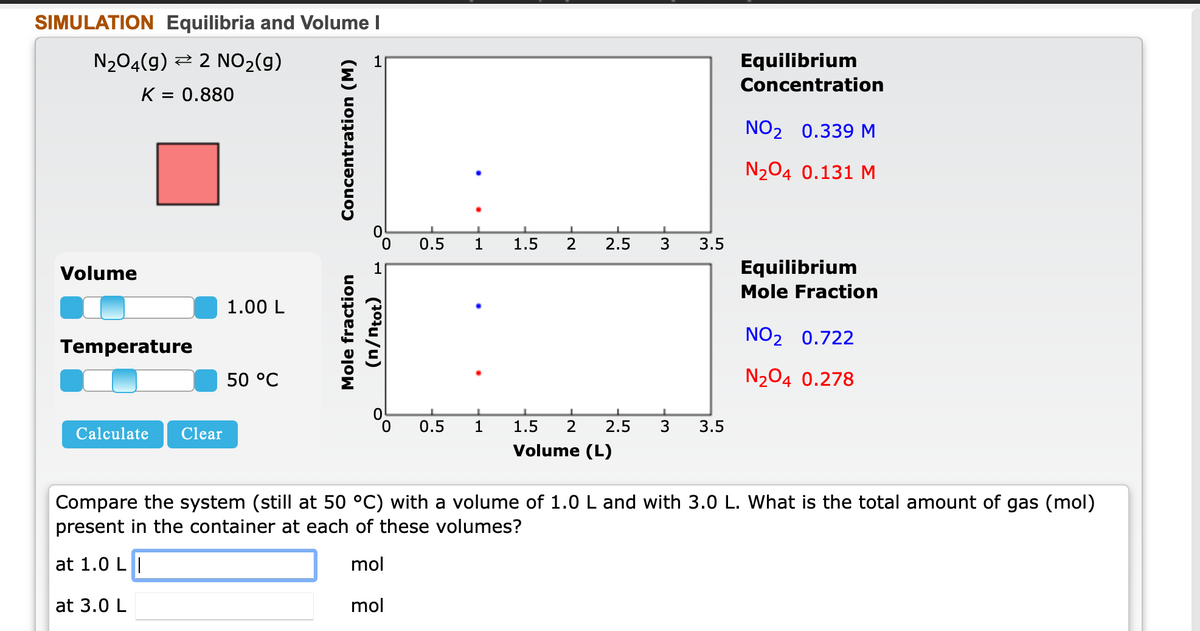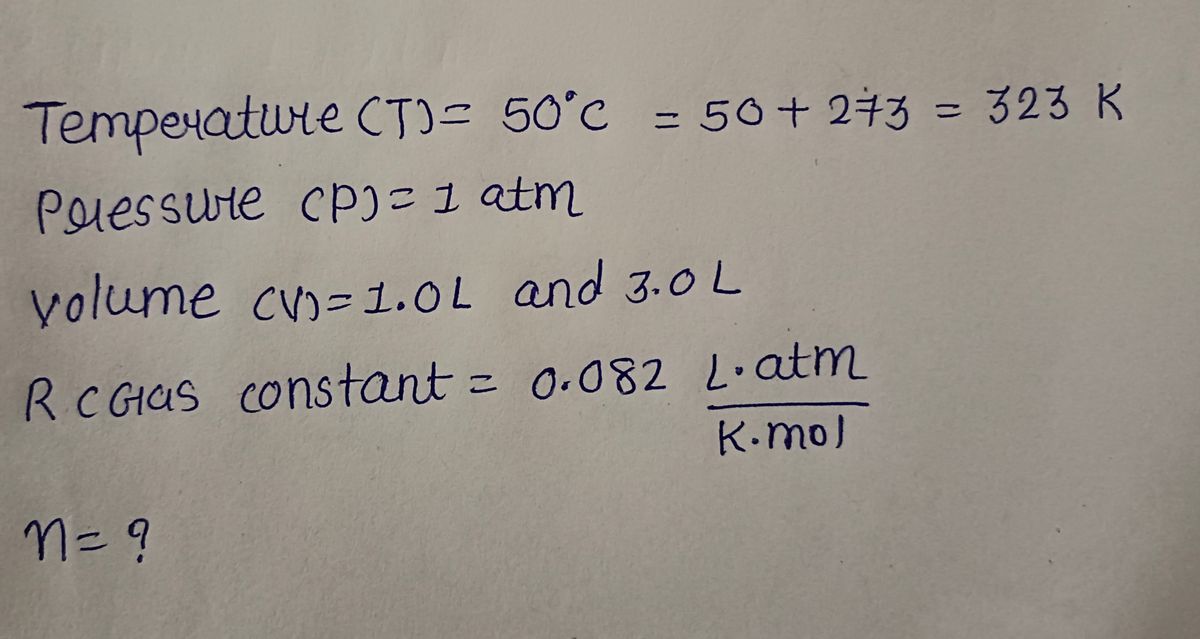SIMULATION Equilibria and Volume I N204(g) 2 2 NO2(g) Equilibrium Concentration K = 0.880 NO2 0.339 M N204 0.131 M 0.5 1 1.5 2 2.5 3 3.5 Equilibrium Mole Fraction Volume 1.00 L NO2 0.722 Temperature 50 °C N204 0.278 0. 0.5 1.5 2 2.5 3 3.5 Calculate Clear Volume (L) Compare the system (still at 50 °C) with a volume of 1.0 L and with 3.0 L. What is the total amount of gas (mol) present in the container at each of these volumes? at 1.0 LI mol at 3.0 L mol Mole fraction Concentration (M) (103u/u)
SIMULATION Equilibria and Volume I N204(g) 2 2 NO2(g) Equilibrium Concentration K = 0.880 NO2 0.339 M N204 0.131 M 0.5 1 1.5 2 2.5 3 3.5 Equilibrium Mole Fraction Volume 1.00 L NO2 0.722 Temperature 50 °C N204 0.278 0. 0.5 1.5 2 2.5 3 3.5 Calculate Clear Volume (L) Compare the system (still at 50 °C) with a volume of 1.0 L and with 3.0 L. What is the total amount of gas (mol) present in the container at each of these volumes? at 1.0 LI mol at 3.0 L mol Mole fraction Concentration (M) (103u/u)
Chemistry
10th Edition
ISBN:9781305957404
Author:Steven S. Zumdahl, Susan A. Zumdahl, Donald J. DeCoste
Publisher:Steven S. Zumdahl, Susan A. Zumdahl, Donald J. DeCoste
Chapter1: Chemical Foundations
Section: Chapter Questions
Problem 1RQ: Define and explain the differences between the following terms. a. law and theory b. theory and...
Related questions
Question

Transcribed Image Text:SIMULATION Equilibria and Volume I
N204(g) 2 2 NO2(g)
Equilibrium
Concentration
K = 0.880
NO2 0.339 M
N204 0.131 M
0.5
1
1.5
2.5
3.5
Volume
Equilibrium
Mole Fraction
1.00 L
NO2 0.722
Temperature
50 °C
N204 0.278
0.
0.5
1
1.5
2
2.5
3
3.5
Calculate
Clear
Volume (L)
Compare the system (still at 50 °C) with a volume of 1.0 L and with 3.0 L. What is the total amount of gas (mol)
present in the container at each of these volumes?
at 1.0 L||
mol
at 3.0 L
mol
Mole fraction
Concentration (M)
(101u/u)
Expert Solution
Step 1

Trending now
This is a popular solution!
Step by step
Solved in 3 steps with 3 images

Knowledge Booster
Learn more about
Need a deep-dive on the concept behind this application? Look no further. Learn more about this topic, chemistry and related others by exploring similar questions and additional content below.Recommended textbooks for you

Chemistry
Chemistry
ISBN:
9781305957404
Author:
Steven S. Zumdahl, Susan A. Zumdahl, Donald J. DeCoste
Publisher:
Cengage Learning

Chemistry
Chemistry
ISBN:
9781259911156
Author:
Raymond Chang Dr., Jason Overby Professor
Publisher:
McGraw-Hill Education

Principles of Instrumental Analysis
Chemistry
ISBN:
9781305577213
Author:
Douglas A. Skoog, F. James Holler, Stanley R. Crouch
Publisher:
Cengage Learning

Chemistry
Chemistry
ISBN:
9781305957404
Author:
Steven S. Zumdahl, Susan A. Zumdahl, Donald J. DeCoste
Publisher:
Cengage Learning

Chemistry
Chemistry
ISBN:
9781259911156
Author:
Raymond Chang Dr., Jason Overby Professor
Publisher:
McGraw-Hill Education

Principles of Instrumental Analysis
Chemistry
ISBN:
9781305577213
Author:
Douglas A. Skoog, F. James Holler, Stanley R. Crouch
Publisher:
Cengage Learning

Organic Chemistry
Chemistry
ISBN:
9780078021558
Author:
Janice Gorzynski Smith Dr.
Publisher:
McGraw-Hill Education

Chemistry: Principles and Reactions
Chemistry
ISBN:
9781305079373
Author:
William L. Masterton, Cecile N. Hurley
Publisher:
Cengage Learning

Elementary Principles of Chemical Processes, Bind…
Chemistry
ISBN:
9781118431221
Author:
Richard M. Felder, Ronald W. Rousseau, Lisa G. Bullard
Publisher:
WILEY